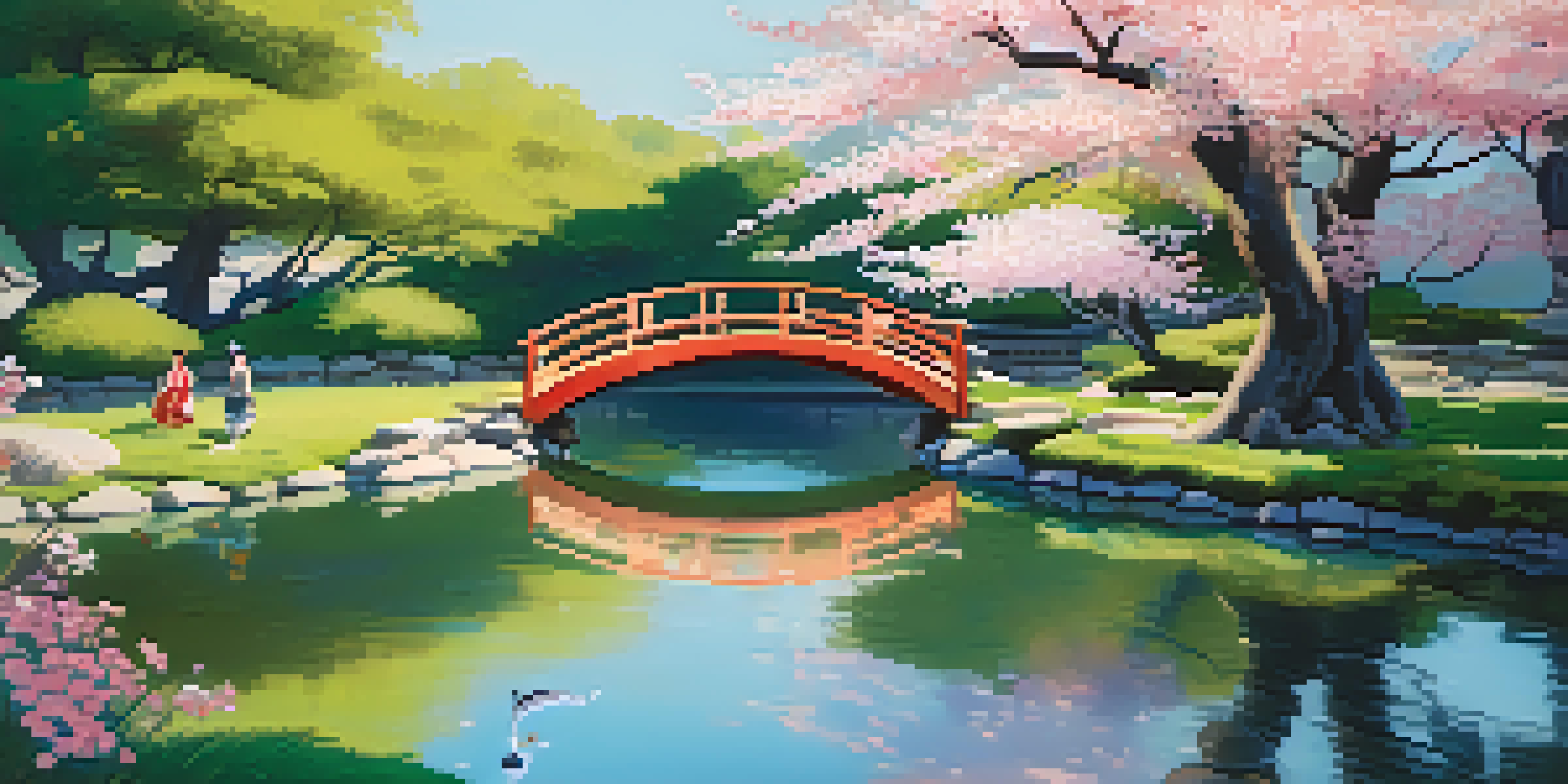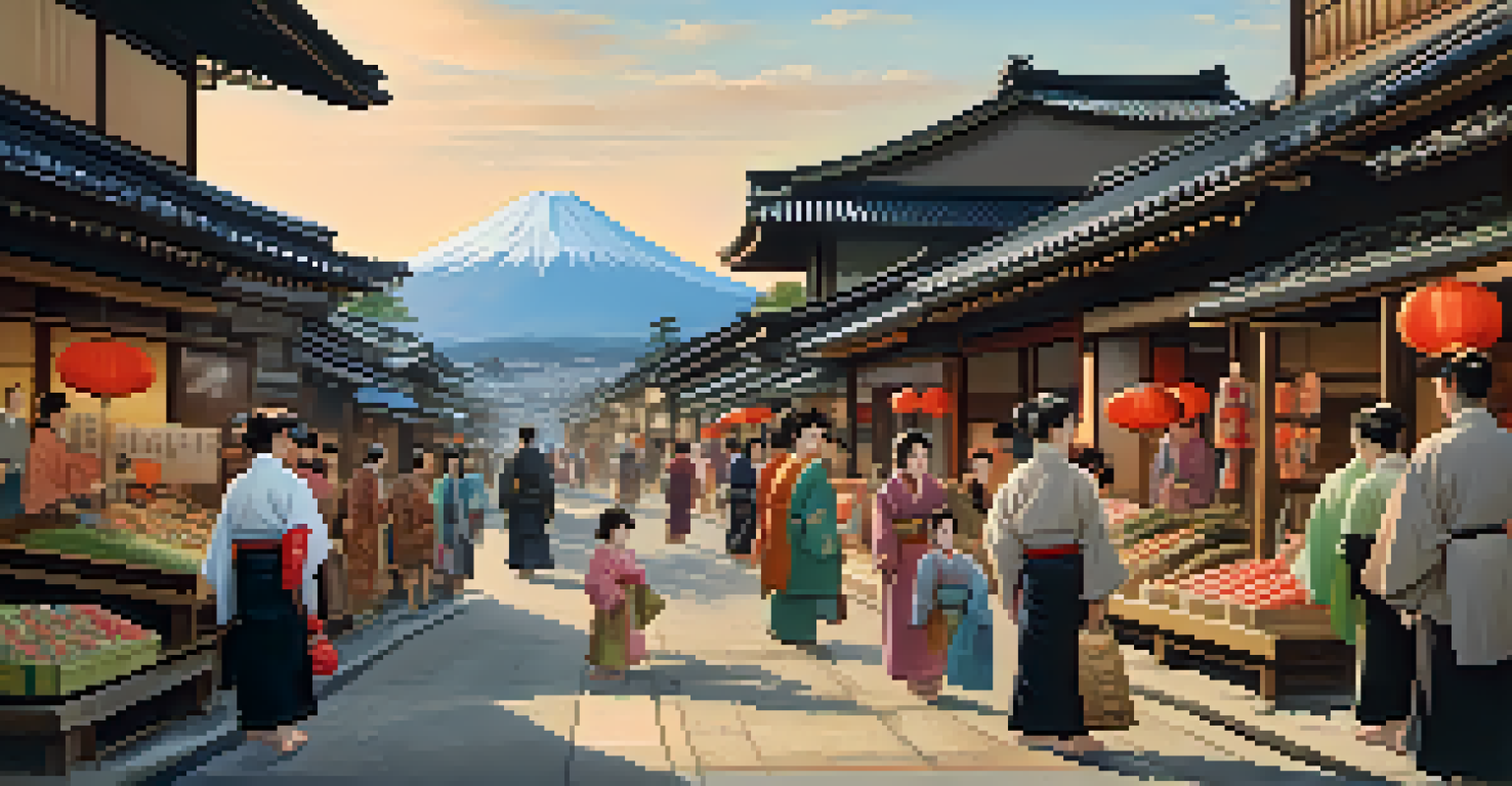Japanese Woodblock Prints and Their Impact on Impressionism

Understanding Japanese Woodblock Prints
Japanese woodblock prints, known as 'ukiyo-e', emerged in the 17th century and became a popular art form that depicted everyday life, landscapes, and beautiful women. These prints were created using a meticulous process that involved carving images into wooden blocks, inking them, and then pressing them onto paper. Artists like Hokusai and Hiroshige became famous for their striking and colorful prints, which captured the essence of Japanese culture.
The beauty of Japanese art is that it is not just visual; it is an expression of a way of life.
The technique allowed for a vibrant use of color and intricate details, making each print a unique work of art. Moreover, the themes often reflected the transient beauty of nature and the world around us, resonating deeply with viewers. This focus on capturing fleeting moments of beauty would later influence Western art styles in profound ways.
As these prints began to reach Europe in the late 19th century, they sparked curiosity and admiration among artists and collectors. This cross-cultural exchange became a pivotal moment in art history, as it laid the groundwork for a new artistic movement that sought to break away from traditional European styles.
The Arrival of Japanese Prints in Europe
The fascination with Japanese woodblock prints began in Europe during the 1850s when Japan opened its ports to international trade. This influx of Japanese culture captivated artists, collectors, and the general public, leading to exhibitions and publications showcasing these unique prints. The aesthetic appeal and craftsmanship of ukiyo-e prints were instantly recognizable and distinct from traditional European art forms.

Many artists, including Vincent van Gogh and Edgar Degas, collected these prints and incorporated their elements into their work. They were drawn to the bold colors, unusual compositions, and innovative perspectives that Japanese artists mastered. This admiration was not just superficial; it was a genuine appreciation for a different approach to visual storytelling.
Cultural Exchange Shaped Art Movements
The influence of Japanese woodblock prints on Impressionism sparked a transformative cultural exchange that enriched artistic expression across borders.
As these prints circulated, they had a ripple effect throughout the art community. Artists began to experiment with their techniques, leading to a shift in how they approached their own work. The influence of Japanese prints became a catalyst for change, encouraging artists to embrace new ideas and aesthetics.
Key Themes of Japanese Influence in Impressionism
One of the most significant themes that Impressionists borrowed from Japanese woodblock prints was the emphasis on light and color. The use of vibrant, flat colors in ukiyo-e prints inspired artists to explore the effects of natural light in their own paintings. This departure from the muted palettes and detailed realism of previous art movements allowed for a more emotive and dynamic representation of the world.
Art is not what you see, but what you make others see.
Additionally, the Japanese technique of using asymmetrical compositions and cropping techniques brought a fresh perspective to Impressionist works. Artists began to experiment with unconventional framing and angles, drawing the viewer's eye to specific details rather than adhering to traditional symmetry. This shift helped convey a sense of spontaneity and movement, which became hallmarks of Impressionism.
Moreover, the themes of everyday life and nature, prevalent in Japanese prints, resonated with Impressionist artists. They sought to capture the beauty in ordinary moments, whether it was a bustling street scene or a tranquil landscape. This shared focus on the fleeting nature of life further solidified the connection between these two art forms.
Artists Influenced by Japanese Woodblock Prints
Notable Impressionist artists like Claude Monet and Pierre-Auguste Renoir were significantly influenced by Japanese prints. Monet, for instance, was particularly captivated by Hokusai's work, which inspired his use of color and composition in his own garden series. He admired how Japanese artists captured the essence of a scene rather than its minutiae, a philosophy that he adopted in his paintings.
Renoir, on the other hand, was drawn to the playful and vibrant depictions of social life found in ukiyo-e prints. He incorporated similar themes into his works, showcasing the joy and intimacy of human relationships. This blending of influences enriched the Impressionist movement, allowing it to evolve and resonate with broader audiences.
Japanese Techniques Inspired Impressionism
Impressionist artists adopted Japanese techniques, such as bold colors and innovative compositions, leading to a new approach in their work.
Moreover, the fascination with Japanese art extended beyond just a few artists. Galleries began to display collections of Japanese prints, and soon, the aesthetic became a significant part of the artistic dialogue in Europe. This cross-pollination of ideas fostered a creative environment that encouraged innovation and experimentation.
The Role of Color in Impressionism and Ukiyo-e
Color played a pivotal role in both Japanese woodblock prints and Impressionism, with each movement exploring its emotional and symbolic potential. In ukiyo-e, color was often used not just to depict reality but to evoke specific feelings or moods. Artists employed a striking palette that highlighted the beauty of nature and the human experience, which Impressionists found incredibly inspiring.
Impressionists embraced this bold use of color, experimenting with new techniques such as broken color and complementary contrasts. This approach allowed them to capture the effects of light and atmosphere in ways that were previously unexplored. The result was a vibrant and lively portrayal of the world that resonated with viewers, much like the vivid imagery found in Japanese prints.
Through this shared emphasis on color, both movements sought to transcend mere representation, aiming instead to evoke emotion and a sense of immediacy. The interplay of light and shadow, along with the rich color palettes, became defining characteristics that linked Impressionism to its Japanese predecessors.
The Lasting Impact on Modern Art
The influence of Japanese woodblock prints on Impressionism laid the groundwork for many modern art movements that followed. The bold colors, innovative compositions, and focus on everyday life inspired artists well into the 20th century. Movements such as Fauvism and Abstract Expressionism drew from these principles, further evolving the use of color and form in art.
Moreover, the appreciation for non-Western artistic traditions has encouraged a more inclusive and diverse approach to art history. By recognizing the impact of Japanese woodblock prints, art scholars and enthusiasts alike have fostered a greater understanding of how cultural exchanges shape creative expression.
Legacy of Japanese Prints in Modern Art
The impact of ukiyo-e prints continued to inspire modern art movements, showcasing the lasting significance of this artistic dialogue.
Today, the legacy of this artistic exchange continues to inspire contemporary artists around the world. The dialogue between Eastern and Western artistic philosophies remains a powerful reminder of how interconnected our creative journeys can be, transcending borders and enriching our collective experience.
Conclusion: A Cultural Exchange That Transformed Art
In conclusion, the relationship between Japanese woodblock prints and Impressionism exemplifies the beauty of cultural exchange in the art world. This interaction not only influenced the techniques and themes of Impressionist artists but also paved the way for future modern art movements. It highlights how inspiration can flow across borders, fostering creativity and innovation.
The vibrant colors, unique perspectives, and focus on the fleeting moments of life that both movements embraced continue to resonate with artists and audiences alike. By celebrating this cross-cultural influence, we gain a deeper appreciation for the rich tapestry of art history and its ability to connect us all.

As we reflect on this historical collaboration, it's essential to recognize the importance of openness to new ideas and perspectives. Just as Impressionism was transformed by Japanese prints, our own creative journeys can be enriched by embracing and exploring diverse influences.